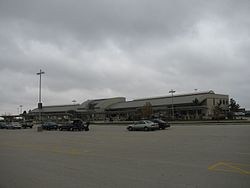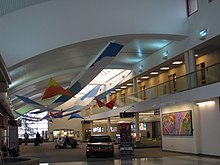avia.wikisort.org - Aerodrome
Central Illinois Regional Airport at Bloomington-Normal (IATA: BMI[2], ICAO: KBMI, FAA LID: BMI) is a public airport in McLean County, Illinois,[1] three miles east of Bloomington[1] and southeast of Normal. Owned by the Bloomington-Normal Airport Authority,[1] it is also known as Central Illinois Regional Airport (CIRA).
Central Illinois Regional Airport at Bloomington-Normal | |||||||||||||||
|---|---|---|---|---|---|---|---|---|---|---|---|---|---|---|---|
 | |||||||||||||||
 Landside view of terminal | |||||||||||||||
| |||||||||||||||
| Summary | |||||||||||||||
| Airport type | Public | ||||||||||||||
| Owner | Bloomington-Normal Airport Authority | ||||||||||||||
| Serves | Bloomington / Normal, Illinois | ||||||||||||||
| Elevation AMSL | 871 ft / 265 m | ||||||||||||||
| Coordinates | 40°28′38″N 088°54′57″W | ||||||||||||||
| Website | www.CIRA.com | ||||||||||||||
| Map | |||||||||||||||
 BMI Location of airport in Illinois  BMI BMI (the United States) | |||||||||||||||
| Runways | |||||||||||||||
| |||||||||||||||
| Statistics (2019) | |||||||||||||||
| |||||||||||||||
Source: Federal Aviation Administration[1] | |||||||||||||||
The National Plan of Integrated Airport Systems for 2011–2015 categorized it as a primary commercial service airport.[3] Federal Aviation Administration records say the airport had 262,846 passenger boardings (enplanements) in calendar year 2008,[4] 243,448 in 2009 and 274,677 in 2010.[5]
The 2013 Federal sequester would have resulted in the closure of the airport's control tower, but the Federal Aviation Administration ultimately reversed its decision.[6]
History

The airport dates to the spring of 1927, when farmer Herman Will opened a 70-plus-acre tract in rural Normal Township. Bordering the field to the west was the recently-paved Illinois 2 (today U.S. 51/Main Street), and to the east was the Illinois Central Railroad (today Constitution Trail). Along the IC, at the northeast corner of the airport grounds, was Kerrick, a busy grain elevator station that remains a local landmark. The Bloomington Flying Club helped rally the general public and local leaders behind the economic promise of "heavier-than-air" flight. The club owned a "Jenny"-type open-cockpit biplane, and the non-profit organization evidently helped pay for both the construction of a hangar and day-to-day operations of the field. Will offered to rent the field to the city of Bloomington for $1,000 a year, but there was little enthusiasm for a municipally owned or operated airport. In 1928, the Normal field featured a six-plane hangar, fueling pump, wind cone, a circle of crushed stone 100-feet in diameter (the purpose of which was to identify the field from the air), and 75 acres of "comparatively level ground."
The airport dedication was held on May 30, 1928 and witnessed by some 10,000 area residents. Local and visiting pilots staged an air show of "stunts and jumps and aerial tricks," according to The Pantagraph. There was "premier" stunt pilot Steve Lacey, representing the Air King factory in Lomax, Illinois, and Bloomington-raised escape artist Nathan B. Winslow, who thrilled spectators by freeing himself from a straight jacket during flight. A few weeks after the dedication, the U.S. Department of Commerce placed the Normal field on its list of officially recognized airports.
The following summer, on July 11, 1929, a larger crowd, estimated at 15,000, gathered at the airfield for the Central Illinois Air Derby. Billed at the time as the greatest such event in Illinois outside of Chicago, the show included four U.S. Army "ships" from Chanute Field in Rantoul, civilian aviators from places like Aurora, Champaign, Joliet and Kankakee, aerial "stunting" contests and races, parachutists and an air parade over downtown Bloomington.
Despite the efforts of local aviation enthusiasts and the business community, attempts to establish long-term passenger service at the Normal field ended in failure. In the fall of 1931, Century Air Lines added Bloomington to its Chicago-to-St. Louis route, and the little grassy square (recently enlarged by 35 acres) now served as an aerial portal to the wider world. Unfortunately the wet winter of 1931-1932 made the field too mushy for the carrier's Stinson tri-motor airplanes. The following spring, American Airways assumed Century's role, but after only two days (May 1–2) the company terminated service to the little airfield, and once more Bloomington lost its place on the air map.
Opposition to a municipally operated airport weakened with the promise of federal dollars through the Civil Works Administration, one of President Franklin D. Roosevelt's many "alphabet" New Deal programs. In mid-December 1933, during the height of the Great Depression, local officials settled on a 164-acre site east of Bloomington along Illinois 9. The new airfield (since renamed the Central Illinois Regional Airport—or CIRA for short) was dedicated in late October 1934.
Nothing survives of the old airport, but a historic marker near the north end of Constitution Trail commemorates the site. The marker is on the trail's west side, opposite the Kerrick elevators. Much of the airport grounds are now occupied by the unfinished warehouse of shuttered local manufacturer Wildwood Industries.
Facilities
The airport covers 1,968 acres (796 ha) at an elevation of 871 feet (265 m). It has two runways: runway 2/20 is 8,000 by 150 feet (2,438 x 46 m) concrete and runway 11/29 is 6,525 by 150 feet (1,989 x 46 m) asphalt/concrete.[1]
In 2011 the airport had 28,016 aircraft operations, average 76 per day: 62.5% general aviation, 18.5% air taxi, 17.7% airline and 1.3% military. 89 aircraft were then based at the airport: 81% single-engine, 8% multi-engine, and 11% jet.[1]
On November 5, 2001, the airport opened a new $14 million terminal building, three times larger than the previous terminal. The new terminal has four ground level boarding gates (Gates 1–4) and five second level gates (Gates 5–9). Gates 3, 4, 5, 6, 8, and 9 have jetways. Gates 1, 2 and 7 are jetway capable but are not currently equipped. The terminal has two baggage carousels at ground level. Conference rooms and a VIP lounge cater to business travelers. Free wireless Internet access is available throughout the building.
CIRA has a healthy general aviation presence. The fixed-base operator on the field, Synergy Flight Center, offers standard FBO services, as well as private and advanced flight training, aircraft maintenance, sales, management and charter.
Hangar rental, fueling, and aircraft maintenance facilities are available.
The Prairie Aviation Museum is on the west side of the airport. It is open to the public on Tuesday evenings and all day on Saturdays and Sundays. It exhibits more modern ex-USAF and US Navy aircraft.
Airlines and destinations
Passenger
| Airlines | Destinations | Refs |
|---|---|---|
| Allegiant Air | Orlando/Sanford, St. Petersburg/Clearwater Seasonal: Destin/Fort Walton Beach | [7] |
| American Eagle | Chicago–O'Hare, Dallas/Fort Worth | [8] |
| Delta Connection | Atlanta, Detroit | [9] |
| Frontier Airlines | Denver, Orlando Seasonal: Tampa[10] |
| Destinations map |
|---|
 Bloomington Dallas/Fort Worth Destinations from Central Illinois Regional Airport Red = Year-round destination Green = Seasonal destination Blue = Future destination |
Statistics
For the 12-month period ending December 31, 2019, the airport averaged 55 airport operations per day, or about 20,000 per year. This includes 71% general aviation, 18% commercial, 6% air taxi, and 5% military. For the same period, there are 74 aircraft based on the field: 58 single-engine and 4 multi-engine airplanes, 11 jets, and 1 helicopter.
Top destinations
| Rank | City | Passengers | Airline |
|---|---|---|---|
| 1 | Atlanta, Georgia | 18,410 | Delta |
| 2 | Dallas/Fort Worth, Texas | 16,770 | American |
| 3 | Orlando (Sanford), Florida | 11,650 | Allegiant |
| 4 | St Petersburg, Florida | 11,240 | Allegiant |
| 5 | Denver, Colorado | 5,650 | Frontier |
| 6 | Chicago–O'Hare, Illinois | 5,140 | American |
| 7 | Orlando (International), Florida | 3,710 | Frontier |
| 8 | Destin/Fort Walton Beach, Florida | 1,470 | Allegiant |
| 9 | Detroit, Michigan | 1,080 | Delta |
Accidents and incidents
- 7 April 2015: A Cessna 414A, registration number N789UP, substantially wandered from the correct flight path during an instrument approach to Runway 20 in low visibility and struck terrain in a nose-down attitude, killing the pilot and all six passengers. Investigators found that the glideslope antenna cable had not been securely connected, which rendered some of the avionics useless, increasing the workload for the pilot. Investigators also concluded that the pilot had been awake for 18 consecutive hours before the accident and that the aircraft was loaded with the center of gravity too far aft, rendering it difficult to control. The accident was attributed to "the pilot's failure to maintain control of the airplane during the instrument approach in night instrument meteorological conditions, which resulted in the airplane exceeding its critical angle of attack and an aerodynamic stall/spin. Contributing to the accident were pilot fatigue, the pilot's increased workload during the instrument approach resulting from the lack of glideslope guidance due to an inadequately connected/secured glideslope antenna cable, and the airplane being loaded aft of its balance limit."[13]
See also
 Aviation portal
Aviation portal Illinois portal
Illinois portal- List of airports in Illinois
References
- FAA Airport Form 5010 for BMI PDF. Federal Aviation Administration. effective November 15, 2012.
- "IATA Airport Code Search (BMI: Bloomington-Normal)". International Air Transport Association. Retrieved July 11, 2013.
- "2011–2015 NPIAS Report, Appendix A" (PDF). National Plan of Integrated Airport Systems. Federal Aviation Administration. October 4, 2010. Archived from the original (PDF, 2.03 MB) on 2012-09-27.
- "Enplanements for CY 2008" (PDF, 1.0 MB). CY 2008 Passenger Boarding and All-Cargo Data. Federal Aviation Administration. December 18, 2009.
- "Enplanements for CY 2010" (PDF, 189 KB). CY 2010 Passenger Boarding and All-Cargo Data. Federal Aviation Administration. October 4, 2011.
- Ahlers, Mike M. "Ending 'holding pattern,' FAA cancels plan to close towers". CNN Politics.
- "Allegiant Air". Retrieved 7 January 2017.
- "Flight schedules and notifications". Retrieved 7 January 2017.
- "FLIGHT SCHEDULES". Retrieved 7 January 2017.
- Cridlin, Jay (September 28, 2021). "Tampa airport gets 5 new Frontier routes, including New York". Tampa Bay Times. Retrieved September 28, 2021.
- "RITA | BTS | Transtats". Bureau of Transportation Statistics. January 2017. Retrieved May 18, 2017.
- "NTSB Aviation Accident Final Report CEN15FA190". National Transportation Safety Board. Retrieved 8 February 2019.
External links
- Central Illinois Regional Airport at Bloomington-Normal, official website
- Bloomington airport born of FDR's New Deal - Pantagraph (Bloomington, Illinois newspaper)
- Aerial image as of March 1999 from USGS The National Map
- FAA Airport Diagram (PDF), effective September 8, 2022
- FAA Terminal Procedures for BMI, effective September 8, 2022
- Resources for this airport:
- AirNav airport information for KBMI
- ASN accident history for BMI
- FlightAware airport information and live flight tracker
- NOAA/NWS weather observations: current, past three days
- SkyVector aeronautical chart for KBMI
- FAA current BMI delay information
На других языках
- [en] Central Illinois Regional Airport
[fr] Central Illinois Regional Airport
Le Central Illinois Regional Airport, encore appelé Bloomington/Normal Airport ou CIRA (code AITA : BMI, code OACI : KBMI, code FAA : BMI), est un aéroport de l'Illinois, aux États-Unis.Другой контент может иметь иную лицензию. Перед использованием материалов сайта WikiSort.org внимательно изучите правила лицензирования конкретных элементов наполнения сайта.
WikiSort.org - проект по пересортировке и дополнению контента Википедии